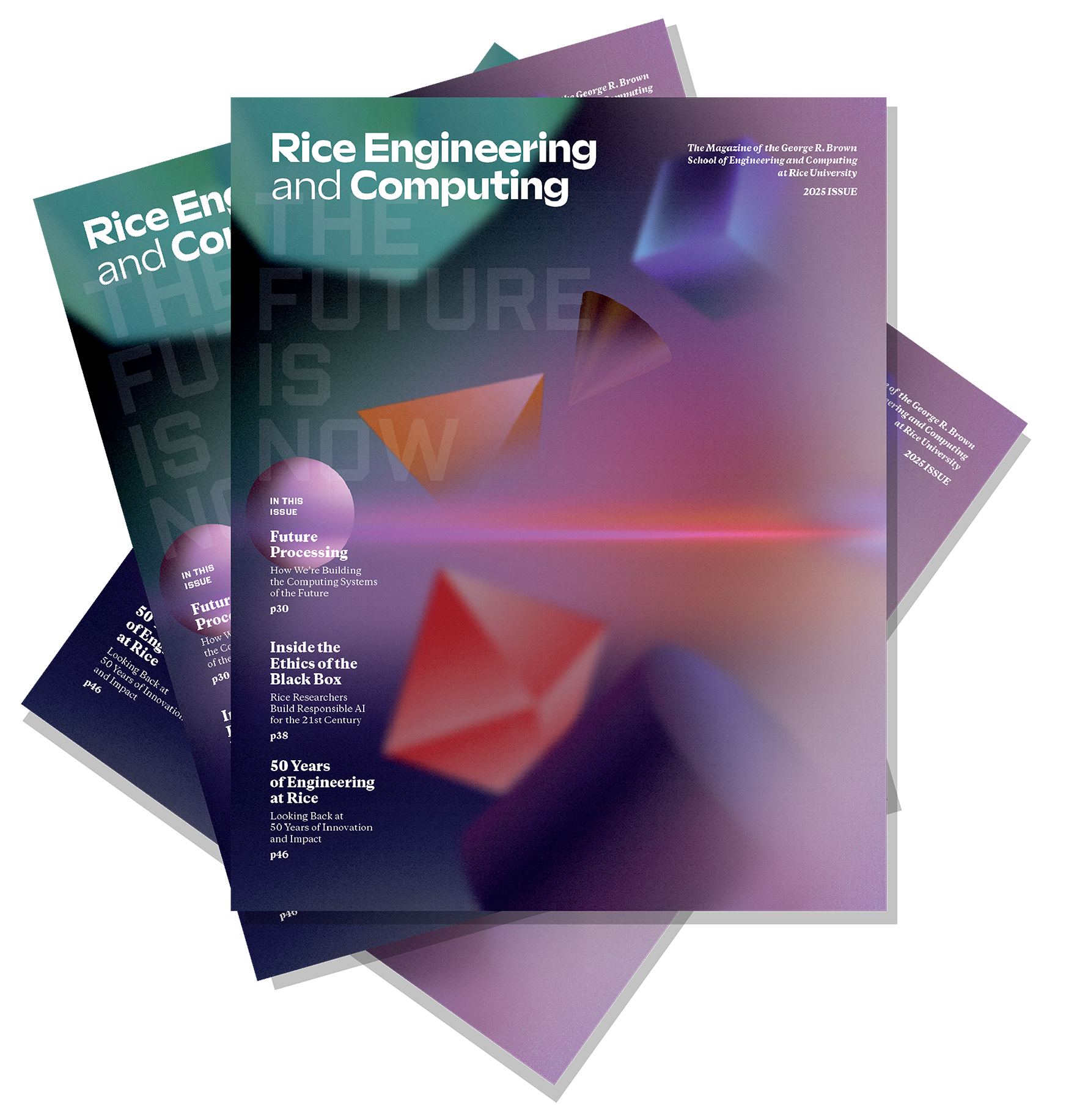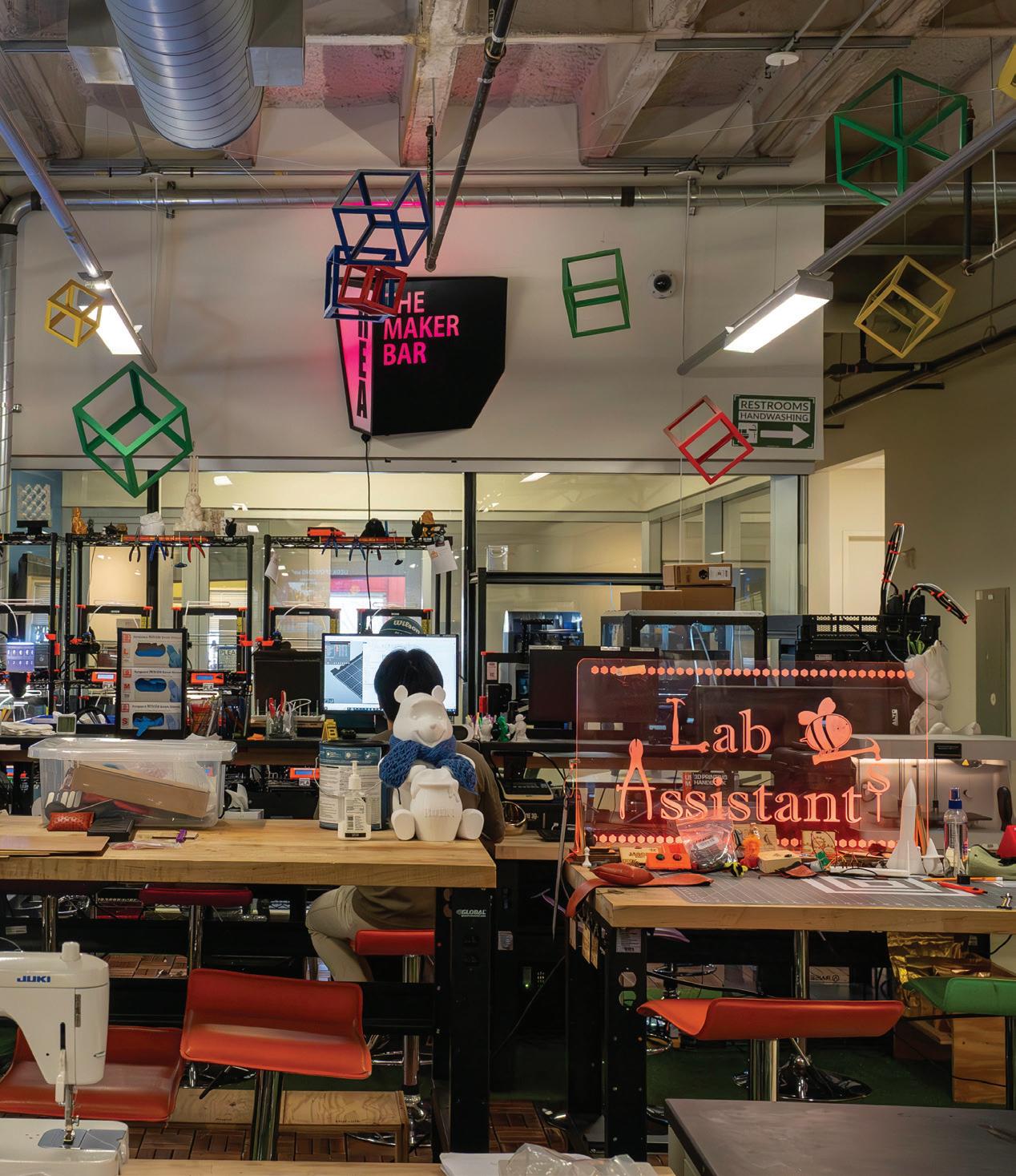
The 2025 issue of Rice Engineering and Computing Magazine is here!
In our 50th anniversary issue, we celebrate the deep and growing connection between engineering and computing. From our early breakthroughs in high-performance computing to today’s advances in AI and data science, Rice has long been at the forefront of computing innovation. This edition highlights some of the people, ideas, and investments shaping what’s next.
The Oshman Engineering Design Kitchen Cooks Up Real-World Solutions
The Oshman Engineering Design Kitchen (OEDK) has been a transformative space for students at the George R. Brown School of Engineering and Computing since its launch in Spring 2009. The OEDK is not your typical lab, but rather a dynamic coworking space for engineering students. It serves as a collaborative, hands-on environment—fondly referred to as the “kitchen”—where students develop original prototypes for clients who need innovative solutions to real-world problems. From hospitals and start-ups to major corporations and individual patients, engineering students create impactful, practical solutions across a variety of industries.
Led by Maria Oden, OEDK director and professor of bioengineering, and Amy Dern, Executive Director of Strategic Initiatives and International Programs, the OEDK is more than just a workspace. It's a hub where even the smallest idea or pitch can evolve into a product that enhances access, quality of life, and sustainability. Students' creative brainstorming comes to life with the support of OEDK staff, technicians and the use of resources such as 3D printers, laser cutters, software, a wet lab, and a machine and wood shop.
These projects developed in the kitchen not only have a significant effect on the communities they serve but also offer invaluable hands-on experience for students. On average, the OEDK serves between 800 and 1,000 students per year, supporting 130 projects throughout the school year, with 85 of those projects funded through the OEDK.
In 2017, with the help of students and OEDK staff, the Maker Bar space was designed as an accessible entry point for all engineering students to learn and practice basic skills while developing their concepts. The colorful and unique space transformed the energetic environment, elevating how students gather and collaborate on team projects.
“It was important for us to create a space that feels open and welcoming, where students can experiment, build confidence, and develop their skills,” said Oden. “The Maker Bar provides that space—it’s where students can take risks and learn through trial and error.”

The REA Maker Bar
One of the most significant contributors to the OEDK’s success is the support from the Rice Engineering Alumni (REA). Since its first team project, the REA has supported the OEDK in numerous ways, including funding a student lounge and other spaces, sponsoring teams, and providing financial backing for various projects. Their generosity also included a campaign to raise funds for new equipment, such as tools and resources necessary to meet the growing needs of the program.
The REA’s most recent commitment culminated in a five-year philanthropic pledge of $20,000 per year, leading to the renaming of the makerspace to the REA Maker Bar. This newly renamed space has brought fresh energy to the OEDK, promoting collaboration across teams, fostering confidence among students, and motivating them to invest in outcomes that benefit the community.
"As an alumni visiting the OEDK, I witnessed how much the makerspace continued to evolve," said Ashton Duke, a past REA board member. "It brings back memories of those late nights I spent as a mechanical engineering student, waiting for my turn to use the tools and space. Being part of the REA gave me the chance to support funding that would meet the growing demands and unique needs of students using the space, which was incredibly fulfilling."
The REA has played a key role in sustaining and enhancing the OEDK’s vision while supporting its mission to empower the next generation of engineers. The projects students work on range from creating accessible medical devices to developing proof-of-concept prototypes for clients with specific needs.
“The tools in the REA Maker Bar are smaller and less intimidating than the larger ones, making it the ideal entry point for students to gain proficiency, build confidence, and begin working on their own projects,” said Dern.
Students can maintain ownership of what they create and share their designs through an open-source platform, allowing others to benefit from their innovations. Projects like the Robocup—originally designed to help a cerebral palsy patient hydrate independently—and a Parkinson’s disease treatment glove are key examples of proof-of-concept ideas developed at the OEDK and made available to the public.
Accessibility, Collaboration, and Innovation
The OEDK’s commitment to accessibility creates an environment where students can thrive, resulting in a positive, high-energy space that enhances both learning and collaboration.
One of the OEDK’s key features is its accessibility. The space provides all the supplies and materials students need to complete their projects, removing barriers that might otherwise hinder their success. Engineering students enter the program with varying levels of experience, or sometimes none at all.
“As a 2019 graduate of the Rice School of Engineering and Computing, I can say the OEDK played a formative role in my own education. I learned in the OEDK how to be an engineer—not just an engineering student,” said Samuel Zorek. “Seeing the OEDK through the lens of an alum and an REA board member years later, I am amazed by the scale of support it provides to students as they build their wide-ranging engineering projects and prepare for their future careers. The OEDK truly is a force multiplier for engineering education, and that was a significant reason for REA’s investment. I am looking forward to seeing all the amazing ways that the OEDK will grow and continue to empower students.”
The REA also continues to offer ongoing support for students working on projects, providing guidance and expertise when needed. This network extends beyond technical advice, with the relationships formed between students and alumni often leading to career opportunities and internships that shape the future of the students involved.
The REA Maker Bar has provided four key components for students: lasting impact, increased energy, enhanced learning, and accelerated innovation. Students finish their projects with greater confidence than when they started and feel more included in the engineering community.
The OEDK is not only a vital educational space for students but also a testament to the power of alumni involvement and support. As the OEDK continues to grow and evolve, the impact of the REA’s support will resonate for years to come, within the engineering community and beyond.
Get Involved
Your active participation in the REA provides invaluable support and resources for engineering students. There are numerous ways to make an impact:
- Mentor students
- Provide an internship opportunity
- Judge a design competition
- Give a tech talk or speak on panels
- Review grant applications
Become a Board Member
The REA is governed by a Board of Directors that consists of more than 20 volunteers from across the country, from as far as Boston and San Francisco. Our Directors represent a wide range of class years, from the Class of 1973 all the way to several members from the past decade. We are career engineers, attorneys, retirees, graduate students, college professors and consultants. We represent established corporations, startups and nonprofits. If you have questions regarding the application or board member requirements, please contact Felix Campos, President Elect of the REA, at felix.campos@alumni.rice.edu.
REA By The Numbers

